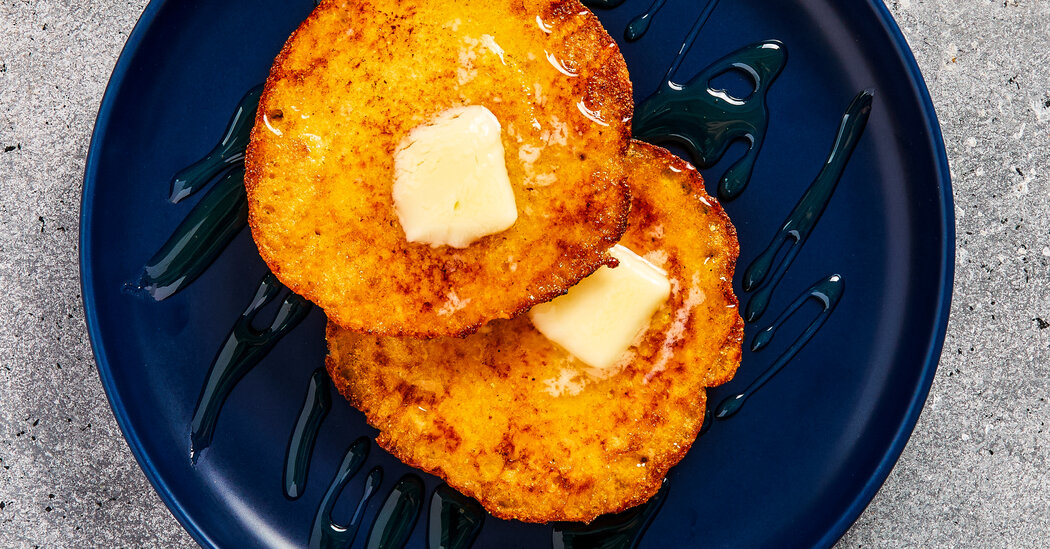Table of Contents
Good morning. I like a savory breakfast on the weekend — maybe a bowl of congee studded with peanuts or a roast beef hero with gravy and mozzarella. Occasionally, there’s a mad dash to Queens for early doubles at Trinciti or a first-in-the-door shrimp and grits at Bubby’s in Manhattan. Those are nice mornings.
Conversely, I’m not at all opposed to breakfast for dinner on the weekend: a stack of waffles with coined bananas and maple syrup, say, or buttermilk pancakes with a big drift of scrambled eggs on the side. French toast amandine to eat with “60 Minutes”? You bet.
This week, I’m thinking it could be this ace recipe for hoecakes (above) that Ramin Ganeshram adapted from one that Justin Cherry uses at George Washington’s Mount Vernon. Cherry developed his recipe for the cornmeal pancakes using archival sources that described the first president’s intense fondness for the dish, which was likely made for him daily by Hercules Posey, his enslaved chef. Cooked in hot butter so the exteriors crisp nicely while the interiors remain moist, the pancakes make for a fine Sunday repast, adorned with more butter and a healthy drizzle of honey.
Tuesday
I’ve been making Suzanne Goin’s recipe for lamb meatballs with spiced tomato sauce for more than a decade. It’s a reliable weeknight meal that the children, with expectant smiles on their faces, call “those meatballs.” Serve with warm pita, and prepare to be asked to make them again.
Wednesday
Eric Kim’s new recipe for peanut butter noodles is one of those fast and easy late-night meals that rewards anyone with peanut butter and soy sauce in the pantry, and Parmesan and butter in the fridge. If you’ve ever inhaled a package of those cheesy peanut butter sandwich crackers you see at the gas station, imagine them even better, and as noodles for dinner, and not in your car.
Thursday
Searing thin, boneless pork chops often results in meat that’s dry and chalky, but Kay Chun’s new recipe for herb-marinated pork chops avoids such a tragedy. Instead of marinating the chops before cooking, you do so afterward, soaking them in a zesty, garlic-and-herb vinaigrette that allows them to absorb a lot of flavor — and to maintain a lot of juiciness. Serve with roasted vegetables or, as good, tucked into a sandwich with a smear of mayonnaise.
Friday
Then you can head into the weekend with an old-school Lenten feast, Naz Deravian’s recipe for fish sticks with peas. I’ll be straight with you: Sometimes I don’t make the fillets into sticks, but leave them whole and roast them in a hot oven for four or five minutes a side. So good.
There are many thousands more recipes waiting for you on New York Times Cooking, at least if you have a subscription. Subscriptions are important, and not just because they allow you to read the recipes. They are what make this whole enterprise possible. If you haven’t taken one out yet, would you consider doing so today? Thanks!
Write for help if you find yourself flummoxed by our technology. We’re at cookingcare@nytimes.com and someone will get back to you, I promise. Or you can write to me in happiness or sorrow: foodeditor@nytimes.com. I can’t respond to every letter. But I read every one I get.
Now, it’s nothing to do with persimmons or eggs in purgatory, but you should read Holland Cotter’s review, in The New York Times, on the new Harlem Renaissance exhibition at the Metropolitan Museum of Art.
Here’s a fascinating piece by Genie N. Giaimo in The Los Angeles Review of Books, “The College Writing Center in Times of Crisis.”


